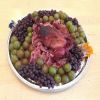Terroir Tapestries: An Interactive Consumption Project

An essay by Jennifer Jacqueline Stratton, a documentary artist and scholar and graduate of Duke’s MFAEDA program, and Ashley Rose Young, a doctoral student in Duke’s history department, was recently published in the edited volume Food and Museums. The piece, entitled “Terroir Tapestries: An Interactive Consumption Project,” describes a project that began in 2014 as part of the HWL Emerging Network Subnature and Culinary Culture. Inspired by the vision of a medieval tapestry and engaged with the rich culinary history of New Orleans, the project sought to turn "both eye and mouth to often overlooked or discarded aspects of food production, distribution, and consumption.”
“Subnature” is a word coined by architectural historian David Gissen for the undesirable spaces that architects and planners have traditionally shunned or treated as problems to be solved. Thomas Parker, HWL Visiting Faculty Fellow, extended the concept to cuisine, applying it to foods and tastes that are smelly, slimy, or associated with the lower classes. It also encompasses the idea of “terroir”—the taste imbued by the soil and environment of a particular place. The concept of subnatural cuisine has special relevance as formerly marginalized foodstuffs are rediscovered, celebrated, and appropriated by today’s foodies.
Stratton and Young write that their project “centered on public engagement with historically significant street foods,” which they served at a campus lunch series hosted by Duke’s Forum for Scholars and Publics, as well as for a lunch event at Rogers-Herr Middle School in Durham. The food wrappings, designed by Stratton and printed with images of street vendors and food markets in New Orleans, were as important as the food itself.
Many of these dishes and ingredients were unfamiliar or strange to participants and as such could be considered "subnatural." During a community lunch series and a corresponding outreach event with high school students, participants ate New Orleans street food such as po'boys and calas and learned about the history of the city's municipal markets and surrounding street food cultures. … These foods were chosen for their potential subnatural qualities. The smoked pigeon prepared for one of these community meals, for example, elicited diverse reactions from consumers who had not considered pigeon meat before. Historically, however, pigeon was consumed in cities across the globe.
Following the sharing of historically significant food items at the community dining events, participants inscribed their own personal "taste reactions" on the food wrappers. Their reactions were drawn and scribbled directly onto the food wrapper imagery dating from the nineteenth to twenty-first centuries, thereby illuminating both continuities and discontinuities in the collective memory of street food cultures in the United States. These taste reactions in combination with the food crumbs and stains create an intimate record of each diner's personal eating experience and her engagement with the past. Through a variety of expressive forms—sketches of produce, animals and people, abstract shapes, even poetic phrases—interactions between personal experiences and the historical foods consumed were concurrently created and recorded. For example: "I didn't like the okra salad because it wasn't slimy enough!"; "Pigeon smelled good, but didn't interest my taste buds"; "Okra—slimy in a good way"; or "Smoked Pigeon—soft, juicy, smooth."
The wrappers are the basis for a permanent exhibit, Taste Terroir Tapestries: Interactive Consumption Histories, at the Southern Food and Beverage Museum in New Orleans, an institution Young has been engaged with since she interned there in 2009.
Referenced People
|
Associate Professor of French and Francophone Studies
|
Documentary artist and scholar, PhD Lab in Digital Knowledge Fellow, Franklin Humanities Institute Fellow
|
Ph.D. candidate in History
|




